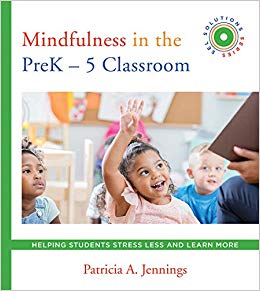Helping Students Stress Less and Learn More
Mindfulness in the PreK-5 Classroom: Helping Students Stress Less and Learn More
By Patricia A. Jennings
(W.W. Norton & Company, 2019 – Learn more)

Academic stress and pressure are getting more and more prevalent in our schools, even with students as young as pre-kindergarten. Our students are spending less time participating in the arts and play while spending more and more time on academic subjects. Children are experiencing “anxiety disorders” at earlier ages, which can negatively impact their mental and physical health.

Understanding mindfulness
What is mindfulness? According to Patricia A. Jennings, author of Mindfulness in the PreK-5 Classroom: Helping Students Stress Less and Learn More, a basic definition of mindfulness is “an awareness of what is happening in the present moment with an attitude of curiosity and openness” (Kabat-Zinn, 2009). It is a “state, a trait, and a practice.”
After reading this important new book, I am excited and honored to share some insights. It is a book that will motivate, reaffirm, and inspire all teachers.
The book is broken into three distinct sections:
Part 1: The definition of mindfulness and how it relates to social and emotional learning
Part II: Examples of mindfulness awareness practices
Part III: How to apply these practices to create a warm learning environment
I remember a conversation with a friend about his daughter who was confident working on math problems at home, but became stressed out in the classroom, basically shutting down during math. As educators, we know this story is familiar.
Now imagine being in your quiet place, being able to concentrate on the sounds and sights in front of you. Imagine the most succulent sweet peach and being able to engage your taste buds, the smells and tastes reminding you of sweet memories.You’re being “mindful.”
Mindfulness practices help us slow down our brains, making it easier to concentrate and focus. So often we lament that our students are not able to focus or pay attention to important information. Mindfulness practices help the teacher to guide our students into being more open and receptive learners. It is a practice that will help that student who “shuts down” in the classroom.
Jennings brings her own school-based experience to this book. She is a Professor of Education at the Curry School of Education at the University of Virginia and led mindful practices in her classroom, preschool through fifth grade, for over twenty-two years. Her ideas and practices are research based with practical application. She “practices what she preaches”!
Teacher and student practice of mindfulness
The author guides the educator on a journey of being mindfully aware of situations in our learning spaces, observing without judgment and allowing students to learn how to problem-solve through self-management. By implementing her practices, we are helping our students become “respectful, responsible, and ready to learn.” We are giving them the tools necessary to be self-sufficient and responsible.
The book begins with simple activities such as Breath Awareness and body calming practices. We can tell our students to “calm down and pay attention,” but often we never teach them how.
An example is the Mind Jar, a jar filled with water and glitter (or eco-friendly glitter) that is used as a model to explain what your mind needs to do to calm down. This unique yet easy-to-apply lesson can be easily adapted to other subject areas such as creative writing exercises that incorporate poetic devices – rhythm, metaphor, and story writing.
Mindfulness is about taking a minute to appreciate things around you such as nature. It’s about giving the students and yourself a chance to slow down your thinking and observe life around you.
Mindfulness is not about a prescribed curriculum or spending your salary on tokens or posters for the classroom. One aspect of being a mindful practitioner is learning how to focus, demonstrated in the activity “Take Five.”
“Students trace each finger of one hand starting with the base of the thumb and ending at the base of the little finger. They inhale as they trace up each finger and exhale as they trace down, resulting in five breaths. They are instructed to feel the sensations of both the touch and breath.” How calming is that! (and an activity you can use when you feel stressed before an observation.)
An essential book
Without a doubt, this book needs to be part of your professional library. Not only is the book packed with research-based activities and anecdotes that all educators will relate to, it will leave you with the inspiration to bring mindfulness into your own life and your students’ lives. I found the resources listed at the end of the book to be an additional gift. The resource section contains a bibliography with book suggestions for general background knowledge, a list of children’s books, and online links.
Mindfulness in the PreK-5 Classroom is a perfect book for educators who wish to begin mindfulness practice in their classrooms and for those already practicing mindfulness. Thank you, Dr. Jennings, for sharing your knowledge and expertise with teachers.
After teaching fourth graders for many years, Linda Biondi is supervising preservice and student teachers at The College of New Jersey and Rider University. Last summer she co-facilitated a week-long writing institute in conjunction with the National Writing Project at Rider University. She volunteers for two service organizations: Homefront and Dress for Success of Central New Jersey – both have a mission to end poverty and homelessness. The mission of Dress for Success is to empower women to achieve through economic independence.


































